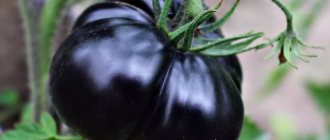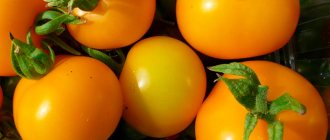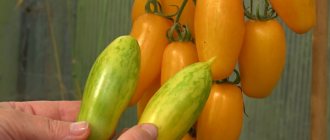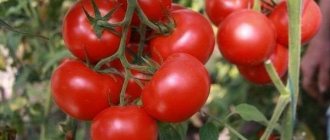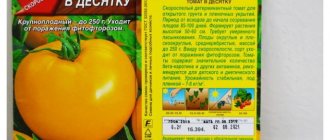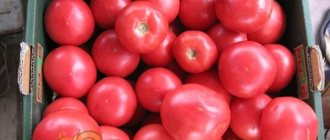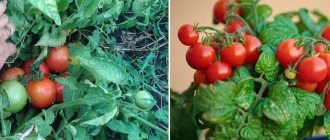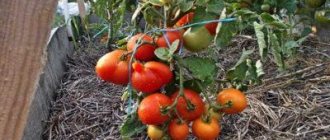Description of the variety
According to the ripening period, the tomato is classified as mid-early. Technical maturity of the fruits occurs after 95-105 days from the moment of sowing, full ripening - after 110-120 days.
Black Cherry plants are huge in size. The weak climbing stem stretches up to 2 meters. In appearance it resembles a grapevine. This is achieved, among other things, due to the dark color of the foliage and complex fruit clusters, similar to grapes. From 15 to 15 tomatoes are formed in one brush.
Fruit
The fruits, as befits cherry tomatoes, are miniature in size. The weight of one tomato does not exceed 20 grams, the diameter is up to 3 cm.
Other fruit features:
- Black-purple color of mature skin and pulp;
- Round, slightly elongated shape;
- 2-3 seed compartments;
- Low dry matter content.
Characteristics and description of the Black Cherry tomato variety, yield
Black cherry tomatoes have a pleasant sweet taste. The variety is also called Black Cherry, Black Cherry or Black Cherry tomato. The fruits of the variety resemble chocolate candy in appearance. The variety was selected by specialists in the USA in 2003. The decision to enter the tomato into the State Register of Russia was made in 2009. Tomatoes of this variety are successfully grown in central Russia. In the northern regions and Siberia, tomatoes are grown only in greenhouses.
Varietal characteristics
Black cherry bushes are quite tall. The tomato stems resemble a grapevine, with dense bunches of tomatoes shaped like ripe cherries. The time from the appearance of the first shoots to the harvest ranges from 112 to 120 days. The tomato is resistant to cladosporiosis. The yield from one bush, subject to compliance with agrotechnical measures, can be more than 5 kg.
The attractiveness of the variety lies in the unusual appearance and high taste of tomatoes. The main disadvantage is the need for constant inspection of plants and bush formation, possible cracking of the tomato skin during ripening.
Cherry tomato is quite sensitive to lack of light and nutrients. Fast-growing stems must be tied up in a timely manner, otherwise they may break off or bend to the ground.
Cherry tomato has a peculiarity - on the bush the side stems are thicker than the main one. The greatest number of ovaries with fruits are on the side shoots. This variety is not a hybrid - having purchased seeds once, you can get them from your harvest for planting the next year.
Description of fruits
Cherry tomatoes are small in size: diameter is about 3 cm, and weight is usually less than 20 g. The pulp has a medium density of a cherry hue; when ripe, the shades of the upper skin present a black palette with a dark purple tint.
This color is formed due to the presence of a large amount of anthocyanin in the fruits - a substance that has a therapeutic effect against colds, has an antiviral effect and increases immunity. Regular consumption of these tomatoes improves vision. It has been observed that anthocyanin acts as a cancer prevention agent.
Each Cherry tomato fruit has 2 – 3 seed chambers. Up to 9 tomatoes can ripen simultaneously in one bunch.
The main advantage lies in the originality of the taste of tomatoes. Their description notes that the tomatoes are sweetish, with an unusual aroma.
The fruits must be collected when they reach biological ripeness. If tomatoes were harvested ahead of schedule, the fruits, which reached technical ripeness on the bush and only then went through the ripening process, have lower taste and fewer nutrients.
Black cherry tomatoes can be stored for quite a long period. They are pickled and preserved as pickles, and added to vegetable or fruit salads. Black cherries are used as decorations for ready-made dishes when serving. Tomatoes are dried and dried for the winter. If fresh tomatoes are moved to a room with a temperature of +5 to +8 degrees, they can be stored for 1 month.
Growing Cherry Tomatoes
The description of the variety includes information about the resistance of tomato bushes to low temperatures. Tomatoes sprout quickly and are highly resistant to diseases. To grow this tomato variety with the best results, Black cherry tomatoes are planted in the soil using seedling method.
Sow the seeds approximately 2 months before planting the seedlings in open ground or in a greenhouse. The distance between bushes should be at least 60 - 70 cm, and between rows - at least 1 meter. The peculiarity of tomatoes is that the plants require pinching.
The characteristics of the variety note that the bushes can grow up to 180 cm, and in greenhouse conditions - up to 2 meters in height. Reviews from those who planted these tomatoes confirm the need to tie the stems to a trellis. An important task for gardeners is to timely remove the shoots of Black cherry tomatoes.
Usually 1 - 2 stems are left. The stepsons are cut off in a timely manner, leaving a cutting of no more than 2 centimeters. Powerful bushes and a large number of fruits force the use of fertilizing.
Irregular watering leads to cracking of the fruits at the moment of ripening. Fruiting continues for a long period, until autumn frosts.
Possible tomato diseases and pests
There is a danger of infection of Black cherry tomatoes with diseases, viruses, and fungi characteristic of nightshades.
The most common infection with phytosporosis is the loss of leaves. The cause of the disease is often high humidity. To avoid the problem, the bushes are treated with Fitosporin, and greenhouses with tomatoes are frequently ventilated.
You can cope with phytosporosis using the traditional method: whey is diluted with water in equal proportions and sprayed on tomato bushes. If the previous options did not have the desired effect, every 15 days the bushes are sprayed with a solution consisting of 1 tablet of Trichopolum per liter of water. Treat the beds with Bordeaux mixture or Mikosan.
The disease blossom end rot appears as darkening on the top of the bush. As a preventive measure, when planting seedlings, add a handful of wood ash and calcium nitrate to each hole - just take 1 tbsp. l. each substance. A lack of microelements and moisture in the soil is indicated by the process in which the foliage of tomato bushes curls.
Plants grown in greenhouse conditions can be affected by aphids and whiteflies, and in open beds bushes are eaten by spider mites. Tomato pests can be controlled by using ready-made insecticides Fufanon or Verticillin.
Traditional methods will also help - spraying the bushes with herbal infusions of chamomile, yarrow or regular tobacco.
Tomatoes: advantages and disadvantages
The main advantages of the Black Cherry tomato:
- Presentable appearance of fruits and impressive exterior of plants;
- Resistance to short-term temperature changes;
- Possibility of transportation to any distance;
- Expressive taste;
- Good yield for tomatoes of this type.
The variety also has its disadvantages:
- Requirements for lighting and temperature control;
- High dependence of yield on soil nutrition;
- The need for garters to trellises.
The best varieties of cherry tomatoes: top 25 most popular
Note! The list of the best cherry tomatoes was prepared based on the degree of popularity of the names of varieties and hybrids, analysis of reviews from experienced gardeners, as well as the personal opinion of the author.
The most popular and best varieties of cherry tomatoes can be called ( alphabetically ):
By the way! The most common cherry varieties are the following (in order of popularity): Balcony Miracle, Little Red Riding Hood and Chio-chio-san.
- three main hits. Next in popularity are Honey Drop, Pinocchio, Red and Yellow Cherries, Vera, Ira, Rose, Porpora, Geranium Kiss (Geranium kiss), Cranberries in Sugar, Paints, etc.
Balcony miracle
- Early ripening variety. It begins to bear fruit 100 days after germination (according to other sources, after 90).
- The plant is determinate, standard, 30-40 cm high. Does not require staking or pinching.
- For growing in open ground, as well as on a windowsill or balcony.
- The fruits are round, smooth, red. Looks like cherries.
- Weight - about 15 grams (according to other sources - 20-30 grams).
- Productivity - 4-5 kg per sq.m (according to other sources - 3.5-4.5 kg).
- Wonderful sweet taste and aroma. For fresh consumption and canning.
- Resistant to late blight.
By the way!
There is a similar variety with lemon-yellow fruits.
Blossam F1
- Early hybrid (90-100 days from germination to fruit harvest).
- The plant is determinate (with limited growth), hybrid. There are 20 fruits in long clusters.
- For growing in open ground with a garter to stakes.
- The fruits are round, beautiful, red, glossy. Number of nests - 2.
- Weight - 20-25 grams.
- Productivity - 2.5-3.0 kg per sq.m.
- Sugar fruits (sweet).
- Children love cherry tomatoes; they are a wonderful decoration for holiday tables, everyday dishes and canned assorted dishes.
- Resistant to the main tomato diseases: nematode, verticillium and fusarium.
Bonsai
- Ultra-early ripening variety (85-90 days from germination to fruiting).
- The plant is determinate, standard, dwarf (20-30 cm). Does not require gartering or pinching. The first inflorescence is laid above the 5-6th leaf, then after 1 leaf (or even without separation by a leaf).
- Recommended for growing on balconies, windowsills, and hanging flowerpots. Plants are planted in flower pots with a soil volume of 1.5-2.0 liters.
- The fruits are round, red. Number of nests - 2.
- Weight - 20-25 g.
- Productivity - up to 0.5-1 kg per plant.
- High taste qualities.
Vera F1
- Super early hybrid. From germination to the first harvest of fruits it takes about 90 days.
- The plant is indeterminate, powerful, characterized by rapid growth in height, compact arrangement of leaves, due to which it is easy to form. The first inflorescence is formed after the 9th node, the subsequent ones - after 2-3 nodes. Fruit clusters are simple, with 15-20 fruits arranged compactly.
- The fruits are fantastically beautiful, obovate in shape, with a tiny “nose” or with some retraction, densely red in color, without a green spot at the stalk.
- Weight -30 g.
- Productivity - up to 15-18 kg per sq.m.
- Sweet, fragrant, thick-walled and pleasant to taste, both fresh and canned.
- Resistant to fusarium, verticillium, root-knot nematodes.
Cherry black
- Early ripening variety, 112 days from germination to fruiting (according to other sources, 100-105 days).
- The plant is indeterminate (with unlimited growth), more than 2 m high. Form into one stem, removing all the “stepchildren”. When the 5th inflorescence is formed, the lower leaves begin to be removed 2-3 per week. After the formation of 8-10 brushes, the shoot is pinched, leaving 2 leaves above the last brush.
- For cultivation in film greenhouses.
- The fruits are round, brown in color (purple-brown). The number of nests is 2-3.
- Weight - 18-20 grams.
- Excellent dessert taste, cherry tomatoes are very sweet and juicy, with a bright, pleasant aroma.
- For preparing fresh salads, delicious appetizers and colorful canned assorted dishes.
- Productivity - 3.5 kg per sq.m (according to other sources, 6.5-7 kg).
Cherry yellow
- Early ripening variety (92-96 days from germination to fruiting).
- The plant is indeterminate, semi-spreading, medium-branched, medium-leaved, more than 2 meters high. Form into one stem, removing all the “stepchildren”. The first inflorescence is laid above the 8-9 leaf, the subsequent ones - after 3 leaves. A long raceme with 20-40 fruits gives the plants a special decorative appearance.
- For cultivation in film greenhouses and open ground (with a garter to stakes).
- The fruits are round, smooth, and yellow in color.
- Weight - 15-20 g.
- Productivity - 1.0-2.0 kg per plant.
- Excellent sweet taste.
- Universal use: for fresh consumption, also suitable for canning with brushes.
- Susceptible to TMV and fusarium, highly susceptible to cladosporiosis.
Cherry red
- Early ripening variety (95-100 days from germination to fruiting).
- The plant is indeterminate, semi-spreading, medium-branched, medium-leaved, tall (more than 200 cm). After planting, the plant is formed into one stem, removing all the “stepchildren”. The first inflorescence is laid above the 8-9 leaf, the subsequent ones - after 3 leaves. A long raceme with 20-40 fruits gives the plants a special decorative appearance.
- For cultivation in film greenhouses and open ground (with a garter to stakes).
- The fruits are round in shape and bright red in color. Number of nests 2-3.
- Weight - 15-20 g.
- Productivity - 1.0-2.0 kg per plant.
- Excellent sweet taste.
- Susceptible to TMV and fusarium, highly susceptible to cladosporiosis.
Ira F1
- Early ripening hybrid. From sunrise to the ripening of the first fruits 90-95 days.
- The plant is indeterminate. There are up to 35 fruits in a brush; harvesting is done with brushes or individual fruits.
- Recommended for cultivation in protected ground; cultivation in open ground on a trellis is possible.
- The fruits are ovoid, with a pointed apex, deep red,
- Weight - 30-35 grams.
- Productivity - up to 15 kg per square meter (according to other sources, up to 5.4 kg).
- The fruits have a unique taste, both fresh and canned.
- Resistant to verticillium, fusarium and root-knot nematodes.
Cranberries in sugar
- Early ripening variety.
- The plant is determinate, standard, 25-35 centimeters high, does not require shaping or staking.
- For growing in open ground, film greenhouses and indoor conditions (on a windowsill or balcony).
- The fruits are small, round, sweet, dark red. The number of nests is 2-3.
- Weight - 15 grams.
- Productivity - 2.3-2.8 kg per sq.m.
- The fruits are tasty, juicy, sweet, ideal for preparing salads and whole-fruit canning.
- Resistant to late blight and adverse weather conditions.
F1 paints
- Early ripening hybrid. From germination to the beginning of ripening 95 days.
- The plant is indeterminate. The first inflorescence forms above the 9th leaf, forming about 20 or more fruits in the cluster, depending on the structure - simple or complex.
- The fruits are round, two-chambered, richly yellow in biological ripeness, without a spot at the stalk.
- Weight - 20-25 g.
- Productivity - 3 kg per plant.
- Excellent taste, with uniform pulp density.
- Resistant to tomato mosaic virus, fusarium, cladosporiosis and verticillium.
Little Red Riding Hood
- Early ripening variety. From germination to the beginning of fruiting 85-90 days.
- The plant is determinate, standard, 40-60 cm high. Does not require formation.
- Recommended for open ground, film greenhouses, balconies and window sills.
- The fruit is round, smooth, red. The number of nests is 2-3.
- Productivity - 2-3 kg per square meter. meters.
- Weight - 15-20 grams.
- The taste is excellent, sweet, juicy. Suitable for salads and whole fruit canning.
- Resistant to verticillium wilt, fusarium wilt, and tobacco mosaic virus.
Lyuba F1
- Early ripening hybrid. From germination to the beginning of ripening about 95 days.
- The plant is indeterminate. The first brush is formed above the 9th sheet. 15-20 fruits are formed on one brush,
- The fruits are round in shape, deep red in color,
- Weight - about 30 g.
- Productivity - 12-15 kg per sq.m.
- The fruits have excellent taste and retain good presentation and taste for a long time. Recommended for fresh and canned consumption.
- Resistant to tomato mosaic virus and tomato disease complex.
Honey drop
- Mid-early variety (from germination to fruiting 100-110 days).
- The plant is indeterminate, tall, above 2 meters. Gartering and shaping are required.
- For cultivation in open ground and film greenhouses.
- The fruits are drop-shaped, smooth, honey-colored.
- Weight - up to 30 g (average 10-15 grams).
- Productivity - up to 5 kg per square meter. m.
- Pleasant sweetish taste, with a delicate tomato aroma.
- Universal purpose: for preparing delicious and bright fresh salads, pickles, marinades, delicious snacks and canapés.
Honey candy F1
- Early ripening hybrid (100-105 days).
- The plant is determinate, medium-sized, up to 1 meter high, with weak foliage. The first inflorescence is laid above the 8-9 leaf, the subsequent ones - after 1-2 leaves. On the main stem, 5-6 simple or intermediate clusters are formed, consisting of 14-28 fruits in each.
- The fruits are elongated-oval, bright yellow. Number of nests - 2.
- Weight - 15-20 g.
- Productivity - 4-6 kg per sq.m.
- The fruits are dense, sweet, with a high content of dry matter and sugars. Intended for fresh consumption, for drying and freezing, whole-fruit canning, both separately and as an assortment with red cherry tomatoes.
- Fruits abundantly, amicably and for a long time.
Pinocchio
- Mid-season variety. 105-110 days from germination to fruiting.
- The plant is determinate, standard, compact, 20-35 cm high.
- Recommended for growing on a windowsill indoors, on a balcony or in open ground.
- The fruit is flat-round, smooth, red. The number of nests is 2-3.
- Weight - 15-20 g.
- Productivity - 1-1.5 kg per plant.
- The taste is good or excellent. Universal purpose.
Porpora F1
- Ultra early hybrid.
- The plant is indeterminate, compact, well leafy. 13-15 fetuses are formed on the cyst.
- For greenhouses and open ground.
- The fruits are shaped like perfectly round red-purple balls.
- Weight - 25 grams.
- Resistant to temperature fluctuations, verticillium wilt, fusarium, tomato mosaic virus, nematode and tomato spotted wilt virus.
- The fruits have a high shelf life.
Geranium Kiss (Geranium kiss)
- Early ripening variety, 90-95 days from germination to fruiting,
- The plant is determinate, highly branched, rapidly developing. It has characteristic “potato” leaves.
- The raceme is complex, highly branched, consisting of 50-60 flowers. The brushes form huge beard bouquets with a mass of simultaneously blooming flowers.
- The fruits are oval-shaped with a spout, dense, shiny, red.
- Weight - up to 30-35 g.
- Fruits of dessert taste.
- Universal purpose: for fresh consumption, also excellent for canning whole fruits.
Button
- Early ripening variety.
- The plant is determinate, standard, 50-60 cm high.
- For open ground and film greenhouses. Also suitable for growing in pots at home (on a balcony or windowsill).
- The fruit is round, smooth, red. The number of nests is 2-3.
- Weight - 10-15 grams.
- Productivity - 4.0-4.5 kg per sq.m.
- Very sweet and aromatic, excellent taste.
- Ideal for home cooking, preparing and decorating salads, for baby and diet food, as well as whole-fruit canning.
- Resistant to verticillium wilt and fusarium wilt.
Rose F1
- Early ripening hybrid. From germination to ripening - 90-95 days.
- The plant is determinate, compact, with weak foliage. The first inflorescence is laid over 4–5 leaves, the subsequent ones after 1–2 leaves. 8–12 fruits are formed in a cluster; harvesting is done with brushes or individual fruits.
- The fruits are round in shape with a “spout”, intense pink-raspberry color. Number of nests - 2.
- Weight - 30–35 grams.
- Productivity - 10–12 kg per sq.m (in a greenhouse), 7–8 kg per sq.m. (in open ground).
- High taste qualities.
- Stress-resistant. Resistant to tomato mosaic virus, verticillium wilt, fusarium wilt, blossom end rot, cladosporiosis, and late blight.
Date yellow
- Mid-late variety.
- The plant is semi-determinate, 90-150 cm high, sparsely leafed, the raceme contains 6-8 fruits.
- For growing in greenhouses and greenhouses, as well as in open ground (in the south).
- The fruits are elongated, oval, with a pointed tip, yellow.
- Weight - 20 grams.
- The fruits are similar in shape and sweetness to dates. The pulp is dense and sugary.
- Universal purpose: for salads and canning.
Date red
- Mid-late variety.
- The plant is semi-determinate, 90-150 cm high, sparsely leafed, the raceme contains 6-8 fruits.
- For growing in greenhouses and greenhouses, as well as in open ground (in the south).
- The fruits are elongated, oval, with a pointed tip, red.
- Weight - 20 grams.
- The fruits are similar in shape and sweetness to dates. The pulp is dense and sugary.
- Universal purpose: for salads and canning.
Black bunch F1
- Early ripening hybrid.
- The plant is indeterminate, about 1.5 meters high.
- For open and closed ground.
- The fruits are plum-shaped, with a richly dark (black, blue) peel.
- Weight - 35-70 g (average - 45 grams).
- The fruits have a pleasant aroma and a plum aftertaste (fruit-plum taste).
Note! The pigment appears in the skin under the influence of sunlight at an early stage of ripening. With insufficient sunlight (in greenhouse conditions), the surface of the fruit is less saturated with black color.
Black chocolate
- Mid-season variety
- The plant is indeterminate, tall, requires shaping and staking. There are 10-12 pieces on a brush.
- For film greenhouses.
- Cherry fruits are round, uniformly brown in color with a green spot at the stalk. Number of nests - 2.
- Weight - 20-28 g.
- Productivity - 4.7 kg per sq.m.
- Sweet, with fruity cherry flavor.
- Salad purpose: for fresh consumption.
Cio-chio-san
- Mid-season variety (110-120 days from germination to fruiting).
- The plant is indeterminate (with unlimited growth), medium-sized, medium-branched, medium-leafed. The first inflorescence is laid above the 9th leaf, the subsequent ones - after 3 leaves. A huge branched cluster produces 50 or more fruits.
- For film greenhouses and open ground with a garter to stakes.
- The fruits are plum-shaped (egg-shaped), pink.
- Weight - 30-40 g.
- Productivity - 4.0 kg per plant (or 7.8 kg m2).
- The fruits have an excellent dessert taste.
- Recommended for preparing salads and canning whole fruits.
- Resistant to tobacco mosaic virus.
Chocolate F1
- Mid-season hybrid (115-120 days).
- The plant is indeterminate, 1.8-2 m high, requires staking and shaping. The clusters are simple, long, containing 9-11 fruits.
- For open ground and film shelters.
- The fruits are elongated plum-shaped, brown with dark green stripes.
- Weight - 30-40 g
- Productivity - 6-6.2 kg per sq.m.
- The fruits are juicy and sweet, with an exquisite taste.
- Recommended for fresh consumption and all types of culinary processing.
- Resistant to major diseases and temperature fluctuations.
Other varieties of cherry tomatoes
Naturally, now on the market you can find a huge number of, albeit slightly less well-known, but quite reliable and proven varieties of cherry tomatoes, to name just a few of them:
- Abrek;
- Pineapple;
- Barberry;
- Bunch of grapes;
- Cherry pink;
- Magic cascade;
- A curiosity;
- Kira;
- Kish Mish;
- Strawberry;
- Red scattering;
- Lycopa;
- Lukoshka on the window;
- Rowan beads;
- Plum Drop;
- Spokes;
- Terek;
- Unique;
- Date orange;
- Florida Petite (“tastes so-so, too ordinary”);
- Cherry from Yuri;
- Naughty.
Video: review of cherry hybrids from Semko
Perhaps, cherry tomatoes are more than worthy of every gardener having 5-10 bushes in his or her personal plot. After all, most cherry varieties are quite unpretentious in care and quite resistant to major tomato diseases. And what can we say about their taste and benefits... It’s better to try it yourself, and not store-bought ones, but grown ones yourself. Fortunately, you are now familiar with the variety of their varieties and hybrids.
Video: cherry tomatoes - the best varieties and their features
Growing tomatoes
The most effective for the Cherry Black variety is cultivation under closed conditions. It allows you to provide plants with the necessary temperature conditions and avoid wind loads that threaten to break branches and break off fruit clusters.
IMPORTANT : Seeds are grown in the traditional seedling way.
How to prepare seeds?
Export seeds are usually processed for delivery to the territory of the Russian Federation. However, you should check the package for the presence of the mark: “Do not treat the seeds,” “Seeds are processed,” or similar.
It is enough to disinfect the treated seeds with potassium permanganate and soak in water before planting. For independently collected seeds, seed preparation must be complete, including the following steps :
- Sorting - only strong and healthy seeds are left for planting;
- Disinfection with antiseptics;
- Soaking in stimulating solutions: “Agrofil”, “Epin”, “Zircon”;
- Soak in purified water for 24-48 hours.
Sowing seed material
Seeds are sown using the square-cluster method in containers equipped with drainage holes.
Recommended regime for keeping seedlings:
- Air temperature – 22-24*C;
- Daily watering;
- Feeding with complex means – once every 14 days.
For a week after sowing, the seedlings are kept under film, after emergence - in an open container. Picking is carried out after the appearance of 2-3 leaves.
Rules for planting seedlings
Seedlings are planted for permanent residence 50-60 days after sowing, but not earlier than the last return frost. By this point, the plants should have 5-7 true leaves.
IMPORTANT : The soil in the garden bed must first be cleared of weeds and fertilized with manure at the rate of 7-10 kg per 1 sq.m.
The landing pattern is checkerboard. The plants are characterized by significant spreading, so the planting density should not exceed 2-3 plants per sq.m. Before planting, 200 grams of humus are placed under each bush and a tablespoon of ash is thrown in.
Features and benefits of growing cherry tomatoes
This variety of tomato received its name, as you may have guessed, due to its small shape, which is similar to a cherry.
By the way! Cherry tomatoes include those varieties of tomatoes whose weight ranges from 15-40 grams.
Thus, cherry tomatoes have the following advantages:
- They look and look beautiful on the bush.
And not only on the bush, but also in the salad. It is cherry tomatoes that can decorate any of your culinary delights .
- Ideal for canning whole fruits .
- Many cherry varieties (especially low-growing ones) are suitable for growing at home: on a windowsill or balcony.
- As a rule, they have a very sweet , one might even say, berry (dessert) taste .
- Good for health (especially yellow, black and pink).
By the way! Cherry tomatoes can come in a wide variety of colors - red, pink, yellow (orange), black (brown, burgundy).
The only thing in which cherry tomatoes are inferior to their ordinary (larger-fruited) counterparts is in yield , which is most often significantly lower. But this drawback is more than compensated for by its amazing taste and external characteristics.
As for the peculiarities of growing , there are none as such - cherry tomatoes require almost the same care as ordinary tomatoes.
However, in order to get a decent harvest, and all the tomatoes on the bunches have time to ripen, you need to shape them in time - trim and shoot the bushes (the most important thing is to trim the leaves).
By the way! For more information on how to properly grow cherry tomatoes, see the following video. In it, the author explains in detail and clearly shows how to trim the leaves of cherry tomatoes to get the maximum yield:
Video: how to grow cherry tomatoes - cultivation secrets
Next, we will consider the descriptions and characteristics of the most popular varieties of cherry tomatoes.
Important! As for the growing location, indeterminate tomatoes are more suitable for a greenhouse, while determinate tomatoes are more suitable for open ground. But keep in mind that in closed ground (greenhouse) you will in any case get a much more abundant harvest, although low-growing (dwarf) cherry varieties can also be grown in ordinary greenhouses.
Features of cultivation, planting and care
Caring for black cherry tomatoes is limited to a few simple rules. Among them:
- Loosening. It is necessary to loosen the beds. This way, you will contribute to better oxygen penetration. Due to this, the roots will develop more correctly, and this is fraught with increased productivity.
- Garter. Mandatory rule! These plants bear fruit in large clusters. The weight of the tomatoes causes the stem to break. The result is a damaged culture. You need to tie up bushes on time.
- Feeding. The crop needs to be fed with organic matter. But don't do it often. Once a month will be enough.
- Hardening. If the plant will grow in open ground in the future, this procedure must be carried out. From time to time, take the seedlings outside.
- Harvesting. Harvest the fruits as soon as the desired shade appears. Don't delay this matter! Overripe vegetables quickly lose their taste.
- Watering. Water the plant strictly at the root! Do not get water on the leaves. This will lead to illness.
Advice! Don't neglect regular watering.
This type of plant loves moisture. No matter how dense the wall of the fruit is, cracks will appear from lack of moisture. But there should not be an excess of moisture either. The ideal figure is less than 70%.
If you decide to grow a black cherry tomato, check out the beneficial properties of its fruits. This issue is discussed in detail below.
Sowing the seeds of this variety of tomatoes for seedlings is carried out 60-65 days before the intended planting in a permanent place. Picking seedlings - at the stage of 2 true leaves. When planting seedlings in the ground for 1 sq. It is recommended to place up to 3 plants of this variety per meter of land, and up to 4 when formed into 1 stem.
Further care for tomatoes consists of timely watering, weed removal, pinching, fertilizing with complex mineral fertilizer and preventive measures to protect this crop from diseases and pests.
After looking at the selection
Tomato seeds from collectors
and after seeing the catalogs of private owners with photos and descriptions, you can choose the most interesting and productive varieties of tomatoes. Reviews from gardeners will also help you with this. Enjoy watching.
If you grew Black Cherry tomatoes, please write whether you liked them or not. What was the yield and taste of the fruits like under your climatic conditions? How do you rate the disease resistance of this variety? If possible, attach a photo of the entire bush or individual fruits you grew. Thank you!
Your reviews of the Black Cherry tomato and additions to the description will help many gardeners evaluate this variety objectively and decide whether it is worth planting or not.
This is a natural variety of tomato. Therefore, we recommend taking seeds from a ripe fruit and growing them again next season!
